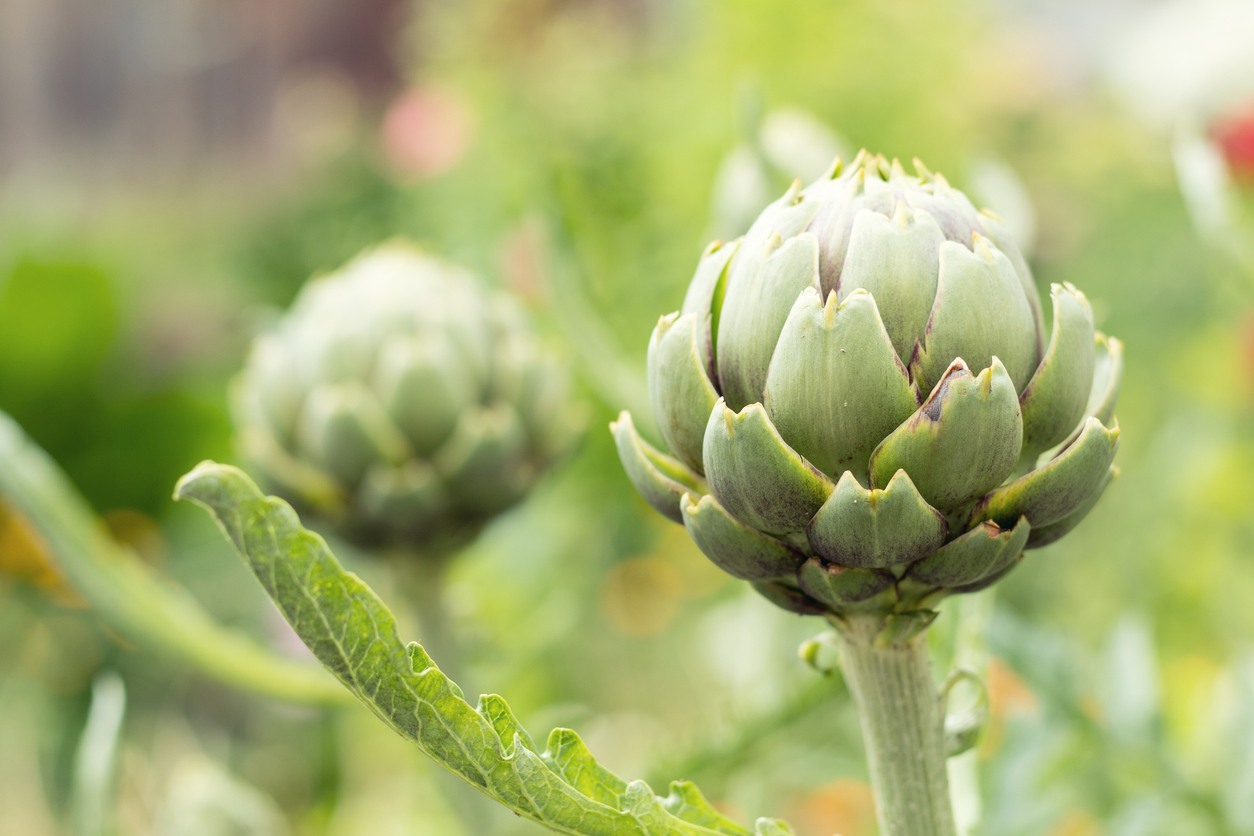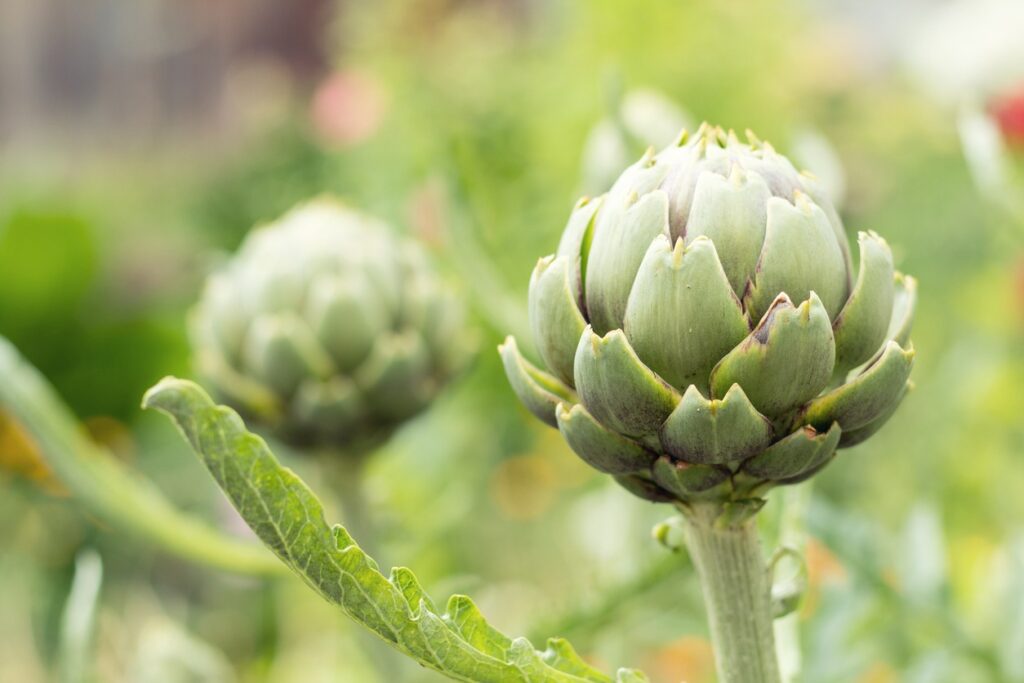Artichoke Plant Care – How To Grow And Harvest Artichoke
Artichoke in your garden is a bold and beautiful plant. The boldness comes from the 6 or more feet of silvery green spread that defies weather conditions and soil types. As for the beauty, well, this is a handsome plant that emanates optimistic joyfulness as long as it’s growing in your garden. Add to that the delicious taste and the many ways you can cook artichoke and you know you got yourself a winner veggie on your hands.
Best of all, this hardy veggie can tolerate different temperatures and weather conditions. All you need to do is to pick the right variety that suits your location and get down to growing without delay or hesitation. This guide covers everything you need to know about growing and caring artichokes as well as the different varieties you can grow. We finish off with a look at the best ways to harvest this sumptuous veggie.
Artichoke at a Glance
Even though botanically speaking artichoke (Cynara scolymus) is in fact a thistle, that doesn’t mean that you should treat it as one. It’s true that some thistle species are invasive, but as every gardener knows, not all thistles are equal. So what makes artichoke different? As it turns out a whole lot of qualities make this veggie a cut above the rest.
A Mediterranean native, the glamorous artichoke has a long history as a culinary staple adorning the tables of the rich and powerful. Both the Greeks and Romans considered it a delicacy. Gourmet chefs boasted about the different ways they could cook the dainty veggie. And while the whole plant is edible, foodies prefer to eat the immature flower in the middle of the plant. It is rich in vitamins, minerals, and is packed with antioxidants.
Artichoke is a herbaceous perennial that grows in the full sun and likes its soil rich but neutral. The mature plant averages between 3 to 6 feet tall and spreads about 5 feet wide. Even though it has USDA hardiness zones between 7 and 11, there are cultivars that can tolerate less than adequate temperatures. If you live outside of those zones, you can still grow artichoke in your garden. It will require a little more work and care on your part though, especially when it comes to winter care.
Artichoke Varieties
Different varieties of artichoke grow in different conditions. In an ideal situation, you can grow it as a perennial. But if you have excessively harsh winters you might have to choose a variety that tolerates cold temperatures and grow it as an annual. In general, artichokes come in two varieties, either globe or elongated. And then each variety has many species and cultivars under it. Here are the most popular artichoke varieties.
- Castel Artichoke: Belongs to the globe variety with a round and juicy shape. It is rich in vitamin B, calcium, and potassium. The best way to cook this variety is to either boil or steam it. It grows well in hardiness zones between 9 and 11 where it produces ample crops between May and October.
- Green Globe Artichoke: Another round variety that can live up to 5 years. It takes about 3 months from the time you plant it until it’s ready to harvest. Each plant produces about 5 heads on average. Chefs prefer this variety because it has a creamy texture and nice flavors. It can grow in zones 7 and above although it needs full sun.
- Violetta Artichoke: This variety belongs to the elongated type. On average the artichoke head is about 5 inches long and 3 inches wide. The head is often green with a hint of violet at the base. Originally from Italy, this variety high tolerance for cool temperatures and can grow in zones as low as 6 and above. It produces between 6 to 8 buds per season.
- Siena Artichoke: Another elongated type that has a unique and oblong shape. Another distinctive feature of this variety is its wine-red color. Besides its tasty buds, the plant has ornamental values as well. Many people like to eat the delicate heads raw since they’re so soft you don’t need to boil or steam them.
- Imperial Star Artichoke: A globe type, this variety is one of the fastest-growing artichokes. It only needs about 85 days to mature. It also tolerates cold winters and will grow well in zones 1 to 6. The mature plant is about 4 feet high and the same in width. It produces about 8 heads every year.
How to Grow Artichoke
As you can see, your location will decide which artichoke variety to grow. In cold areas, Imperial Star is the right variety thanks to its high tolerance to frigid temperatures. This difference in temperature tolerance also reflects on how you would grow each variety. If done right, you can expect to get a good harvest every year. Here’s how to grow the most common varieties of artichoke in easy steps.
- As a full sun lover, artichoke needs a spot in your garden that gets at least 6 hours of sun every day. Plant the veggie in an area facing the south or the west for best results.
- Before you plant your artichoke seeds, you need to till the soil. Use a hoe to break the top 8 inches of the soil and work in plenty of organic materials and compost.
- Start the seeds indoors about 2 months before the last frost. The seedlings have a low tolerance to cold temperatures even if the mature plant can handle it.
- When the weather has improved after the last frost, you can transplant them to their permanent place in the garden.
- Prepare your bed in rows and dig a hole for every seedling.
- Place the seedling in the hole so that the soil mark lines with the top of the hole. Fill it with soil and pack it to push out air pockets.
- Space the plants keeping about 6 feet between each seedling to allow it enough space to grow.
- Water the seedlings after you plant them.
Artichoke Care
Artichoke is a demanding plant when it comes to maintenance and care. This is especially true if you didn’t pick the right variety for your hardiness zone. But as usual, with the right amount of care and experience, you’ll get your artichoke plants to produce a healthy crop every year.
Soil
Sandy or loamy soil is the best type to ensure your artichoke grows well and with fewer problems. To make sure that your soil has the right texture, give it the palm test. After you work the topsoil and mix it with organic materials, grab a fistful of soil and squeeze it in your hand. If it turns into a clump, the soil is heavy and needs more sand. If the soil remains loose in the palm of your hand, then it has the right texture for artichokes. Test the soil beforehand and make sure it has neutral pH levels between 6.5 and 7.5.
Water
Artichoke is a thirsty veggie that needs plenty of water. You will need to water it about 3 times a week. Aim the water at the roots and avoid sprinkling the leaves with water to avoid fungal infections. Adequate amounts of water ensure that you have juicy and tender artichoke heads. Dehydration has adverse effects on the flavors and texture of the veggie. The roots of the plant go deep in the soil so you’ll need to direct the water to the base of the plant. A robust root system ensures the success of this perennial. So protect the roots with a thick layer of mulch that improves the soil water retention. Mulch also prevents the plant from flowering too quickly in the hot weather.
Fertilizer
Not only is the artichoke a thirsty veggie but it’s also a heavy feeder. During the growing season, you need to apply fertilizer at least once a week. Besides the generous amount of organic compost you worked into the soil before planting the veggie, you also need to keep feeding it with a well-balanced fertilizer. Use a 6-6-6 general-purpose fertilizer that gives the hungry roots their fill of nitrogen. It doesn’t like competitive companions so only grow light feeders such as cabbage and peas in the same veggie batch as artichokes. Hold off fertilizing after harvesting and prepare the veggie for the winter.
Pests and Diseases
The tender leaves and flowers of the artichoke attract a few pests. At the top of the list, you will have to contend with aphids and slugs. They both go after the young leaves and flowers and could damage the whole crop. You’ll have to be diligent and get rid of these pests before they spread and become an infestation. Use neem oil to eliminate aphids. As for slugs, you will need to pick them by hand and drown them in a bucket full of water.
The most common disease for artichokes is gray mold. The leaves will turn gray as the infection spreads to the whole plant. The best way to combat the disease is to remove the damaged leaves.
Harvesting Artichoke
For most artichoke varieties, you’ll need to harvest the bud once it reaches about 3 inches in diameter. Artichokes are harvest before they become ripe. If you gather your buds a little too late, they become too hard to eat. Don’t let the flower open up fully since that makes it inedible.
You can use a sharp blade or pruning shears to collect the buds. Cut about three inches of the stem below the flower. Only harvest those flowers with folded bracts.
Wait for the side shoots to form buds. When these small buds are between 1 to 3 inches, you can harvest them as well. These small heads are tender and can be eaten raw.
The harvested artichoke is best stored in the fridge where it will remain fresh for about 3 weeks.


